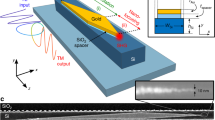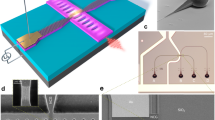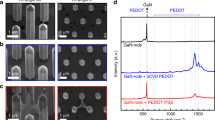Abstract
Optoelectronic integrated circuits can leverage the large bandwidth and low interconnect delay of optical communications. Developing a three-dimensional optoelectronic integrated circuit architecture could then provide increased integration density, improved operation speeds and decreased power consumption. However, the integration of photonics and electronics in 3D geometries is difficult due to conflicts in materials and fabrication methods. Plasmonics can help address the incompatibility of photonic and electronic circuits, but methods for the 3D integration of plasmonics and electronics on a single chip are limited. Here, we report a strategy for the three-dimensional integration of plasmonics and electronics using waveguide-fed slot antennas and carbon nanotube networks. Our low-temperature approach, which is compatible with complementary metal–oxide–semiconductor (CMOS) technology, is based on a metal engineering technique in which different metals with typical structures are used as different functional modules. Using this approach, we demonstrate a series of 3D integrated circuits including photovoltaic-type plasmonic unidirectional receivers, wavelength–polarization multiplexers, and receivers integrated with CMOS signal-processing circuits.
This is a preview of subscription content, access via your institution
Access options
Access Nature and 54 other Nature Portfolio journals
Get Nature+, our best-value online-access subscription
$29.99 / 30 days
cancel any time
Subscribe to this journal
Receive 12 digital issues and online access to articles
$119.00 per year
only $9.92 per issue
Buy this article
- Purchase on Springer Link
- Instant access to full article PDF
Prices may be subject to local taxes which are calculated during checkout





Similar content being viewed by others
Data availability
The data that support the plots within this paper and other findings of this study are available from the corresponding author upon reasonable request.
References
Waldrop, M. M. More than Moore. Nature 530, 145–147 (2016).
Sun, C. et al. Single-chip microprocessor that communicates directly using light. Nature 528, 534–538 (2015).
Aly, M. M. S. et al. Energy-efficient abundant-data computing: the N3XT 1000X. Computer 48, 24–33 (2015).
Shulaker, M. M. et al. Three-dimensional integration of nanotechnologies for computing and data storage on a single chip. Nature 547, 74–78 (2017).
Bhattacharya, P. Semiconductor Optoelectronic Devices (Prentice Hall, Upper Saddle River, NJ, 1994).
Kirchain, R. & Kimerling, L. A roadmap for nanophotonics. Nat. Photon. 1, 303–305 (2007).
Tchernycheva, M. et al. Integrated photonic platform based on InGaN/GaN nanowire emitters and detectors. Nano Lett. 14, 3515–3520 (2014).
Wada, K. A new approach of electronics and photonics convergence on Si CMOS platform: how to reduce device diversity of photonics for integration. Adv. Opt. Technol. 2008, 1–7 (2008).
Chaisakul, P. et al. Integrated germanium optical interconnects on silicon substrates. Nat. Photon. 8, 482–488 (2014).
Brongersma, M. L. & Shalaev, V. M. The case for plasmonics. Science 328, 440–441 (2010).
Ozbay, E. Plasmonics: merging photonics and electronics at nanoscale dimensions. Science 311, 189–193 (2006).
Sorger, V. J., Oulton, R. F., Ma, R.-M. & Zhang, X. Toward integrated plasmonic circuits. MRS Bull. 37, 728–738 (2012).
Avouris, P., Chen, J., Freitag, M., Perebeinos, V. & Tsang, J. C. Carbon nanotube optoelectronics. Phys. Status Solidi B 243, 3197–3203 (2006).
Avouris, P., Chen, Z. & Perebeinos, V. Carbon-based electronics. Nat. Nanotech. 2, 605–615 (2007).
Koppens, F. H. L. et al. Photodetectors based on graphene, other two-dimensional materials and hybrid systems. Nat. Nanotech. 9, 780–793 (2014).
Fiori, G. et al. Electronics based on two-dimensional materials. Nat. Nanotech. 9, 768 (2014).
Zakharko, Y. et al. Multispectral electroluminescence enhancement of single-walled carbon nanotubes coupled to periodic nanodisk arrays. Opt. Express 25, 18092–18106 (2017).
Ansell, D. et al. Hybrid graphene plasmonic waveguide modulators. Nat. Commun. 6, 8846 (2015).
Falk, A. L. et al. Near-field electrical detection of optical plasmons and single-plasmon sources. Nat. Phys. 5, 475–479 (2009).
Liu, Y., Zhang, J., Liu, H., Wang, S. & Peng, L.-M. Electrically driven monolithic subwavelength plasmonic interconnect circuits. Sci. Adv. 3, e1701456 (2017).
Liu, Y., Wang, S., Liu, H. & Peng, L.-M. Carbon nanotube-based three-dimensional monolithic optoelectronic integrated system. Nat. Commun. 8, 15649 (2017).
Maier, S. A. Plasmonics: Fundamentals and Applications (Springer Science & Business Media, Berlin, 2007).
Steigerwald, J. M., Murarka, S. P. & Gutmann, R. J. Chemical Mechanical Planarization of Microelectronic Materials (Wiley, Hoboken, NJ, 2008).
Liu, Y. et al. Van der Waals heterostructures and devices. Nat. Rev. Mater. 1, 16042 (2016).
Peng, L.-M., Zhang, Z. & Wang, S. Carbon nanotube electronics: recent advances. Mater. Today 17, 433–442 (2014).
Liu, Y. et al. Approaching the Schottky–Mott limit in van der Waals metal–semiconductor junctions. Nature 557, 696–700 (2018).
Zhang, J. et al. Resonant slot nanoantennas for surface plasmon radiation in optical frequency range. Appl. Phys. Lett. 100, 241115 (2012).
Liu, Y., Wang, S. & Peng, L. M. Toward high-performance carbon nanotube photovoltaic devices. Adv. Energy Mater. 6, 1600522 (2016).
Liu, Y. et al. Room temperature broadband infrared carbon nanotube photodetector with high detectivity and stability. Adv. Optical Mater. 4, 238–245 (2016).
López-Tejeira, F. et al. Efficient unidirectional nanoslit couplers for surface plasmons. Nat. Phys. 3, 324–328 (2007).
Lin, J. et al. Polarization-controlled tunable directional coupling of surface plasmon polaritons. Science 340, 331–334 (2013).
Yang, J. et al. Broadband surface plasmon polariton directional coupling via asymmetric optical slot nanoantenna pair. Nano Lett. 14, 704–709 (2014).
Qiu, C. et al. Scaling carbon nanotube complementary transistors to 5-nm gate lengths. Science 355, 271–276 (2017).
Wang, F. et al. High conversion efficiency carbon nanotube-based barrier-free bipolar-diode photodetector. ACS Nano 10, 9595–9601 (2016).
Yin, L. et al. Subwavelength focusing and guiding of surface plasmons. Nano Lett. 5, 1399–1402 (2005).
Baudrion, A.-L. et al. Coupling efficiency of light to surface plasmon polariton for single subwavelength holes in a gold film. Opt. Express 16, 3420–3429 (2008).
Neutens, P., Van Dorpe, P., De Vlaminck, I., Lagae, L. & Borghs, G. Electrical detection of confined gap plasmons in metal–insulator–metal waveguides. Nat. Photon. 3, 283–286 (2009).
Lerosey, G., Pile, D., Matheu, P., Bartal, G. & Zhang, X. Controlling the phase and amplitude of plasmon sources at a subwavelength scale. Nano Lett. 9, 327–331 (2008).
Saleh, B. E. A. & Teich, M. C. Fundamentals of Photonics (Wiley, New York, 1991).
Balthasar Mueller, J. P., Leosson, K. & Capasso, F. Ultracompact metasurface in-line polarimeter. Optica 3, 42–47 (2016).
Drezet, A., Genet, C. & Ebbesen, T. W. Miniature plasmonic wave plates. Phys. Rev. Lett. 101, 043902 (2008).
Ellenbogen, T., Seo, K. & Crozier, K. B. Chromatic plasmonic polarizers for active visible color filtering and polarimetry. Nano Lett. 12, 1026–1031 (2012).
Espinosa-Soria, A., Rodriguez-Fortuno, F. J., Griol, A. & Martinez, A. On-chip optimal stokes nanopolarimetry based on spin–orbit interaction of light. Nano Lett. 17, 3139–3144 (2017).
Lee, J. Band-gap renormalization in carbon nanotubes: origin of the ideal diode behavior in carbon nanotube p-n structures. Phys. Rev. B 75, 075409 (2007).
He, Y. et al. Metal-film-assisted ultra-clean transfer of single-walled carbon nanotubes. Nano Res. 7, 981–989 (2014).
Acknowledgements
This work was financially supported by the National Key Research & Development Program of China (Grant No. 2016YF0201902) and the National Natural Science Foundation of China (Grant No. 61621061, 11574011 and 91850104).
Author information
Authors and Affiliations
Contributions
Y.L. led and was involved in all aspects of the project, and performed all of the design, layout, fabrication, testing, simulation and data analysis. J.Z. and L.-M.P. advised on all parts of the project. L.M.P. was in charge of the project. All authors discussed the results and contributed to preparation of the manuscript.
Corresponding authors
Ethics declarations
Competing interests
The authors declare no competing interests.
Additional information
Publisher’s note: Springer Nature remains neutral with regard to jurisdictional claims in published maps and institutional affiliations.
Supplementary information
Supplementary Information
Supplementary Notes 1–16 and Supplementary Figures 1–14
Rights and permissions
About this article
Cite this article
Liu, Y., Zhang, J. & Peng, LM. Three-dimensional integration of plasmonics and nanoelectronics. Nat Electron 1, 644–651 (2018). https://doi.org/10.1038/s41928-018-0176-z
Received:
Accepted:
Published:
Issue Date:
DOI: https://doi.org/10.1038/s41928-018-0176-z
This article is cited by
-
A nano-plasmonic HMIM waveguide based concurrent dual-band BPF using circular ring resonator
Optoelectronics Letters (2024)
-
Low-resistance metal contacts to encapsulated semiconductor monolayers with long transfer length
Nature Electronics (2022)
-
Fully integrated parity–time-symmetric electronics
Nature Nanotechnology (2022)
-
Carbon nanotube-based CMOS transistors and integrated circuits
Science China Information Sciences (2021)
-
Wafer-scale 3D shaping of high aspect ratio structures by multistep plasma etching and corner lithography
Microsystems & Nanoengineering (2020)



